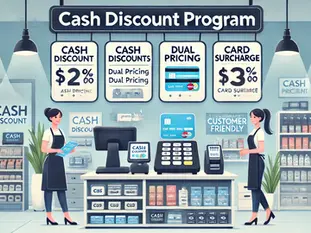
How Dual Pricing Programs Help Business Owners Slash Merchant Fees—Or Even Eliminate Them
Nov 5, 2024
4 min read
0
38
0

You know how much payment processing fees can cut your profits as a business owner. Dual pricing programs are emerging as a practical solution for reducing, and in some cases, nearly eliminating, these fees altogether. By implementing a dual pricing model, businesses can apply a service fee for card payments while offering the regular price for cash payments, providing transparency and savings for you and your customers.
A dual pricing program could be the key to gaining control over credit card fees and boosting your bottom line. Here’s what you need to know about this model and how it could benefit your business.
What Is Dual Pricing?
Dual pricing is a payment model offering customers two pricing options at checkout: cash payments and card transactions. Rather than adding a surcharge specifically for credit cards, the dual pricing approach includes a modest service fee for all card payments, while cash payments are offered at a lower price. This straightforward approach gives customers the choice and can substantially reduce the costs associated with merchant services.
Dual pricing is distinct from cash discounting and card surcharging, making it a flexible, compliant way for businesses to offset processing costs.
The Benefits of Dual Pricing Programs
Significant Reduction in Payment Processing Fees
One of the most significant advantages of a dual pricing model is reducing payment processing fees. With this approach, businesses can pass the cost of processing card transactions onto the customer, effectively lowering or eliminating the fees on your end.
Real-Life Example: Bayou Teche Brewing, processing approximately $100,000 in card payments each month, implemented dual pricing and saw immediate savings of nearly $3,000 monthly. By applying a modest service fee to card transactions, the brewery could maintain competitive pricing for cash-paying customers, ultimately boosting profitability while preserving their market edge.
Improved Cash Flow and Faster Access to Funds
Cash payments provide instant access to funds, unlike card transactions, which can take days to process and settle. A dual pricing model encourages more cash transactions, making funds available for operational costs, reinvestments, or other business needs sooner. Improved liquidity is especially beneficial for businesses that rely on a steady cash flow to stay agile and meet expenses.
Customer Incentives to Choose Cash Payments
Dual pricing gives customers a clear choice: pay a small fee for the convenience of using a card or enjoy a discount by paying with cash. Many customers appreciate having this option and are motivated to pay with money to save. This reduces reliance on credit cards and helps businesses create a customer-friendly model while optimizing for more cash transactions.
Real-Life Example: Flynnstone Decorative Concrete, a valued client of Wingman Payments, implemented dual pricing to offer clients a transparent choice with the formal proposal: card payments with a service fee or ACH payments with no service fee. This flexibility boosted Flynnstone’s close rates, as customers appreciated the clear, upfront pricing and the ability to choose the option that best fit their needs.
Simplicity in Payment Management and Reduced Reconciliation Effort
Cash transactions are often simpler to manage than card payments, which require reconciling with merchant accounts and banks. With more cash sales, businesses can streamline bookkeeping and reduce the time spent on reconciliation, ultimately decreasing the likelihood of accounting errors.
Addressing Common Concerns About Dual Pricing Programs
Customer Reactions to Service Fees
Business owners often worry that customers may resist paying an added fee for using their cards. However, experience shows that clear communication and transparency are key. When signage is prominently displayed, and staff are trained to explain the pricing model, customers typically appreciate the straightforward approach and the chance to save.
Wingman Payments equips its clients with in-store signage and training to help customers understand dual pricing and feel comfortable with the choice.
Compliance with State Regulations
Dual pricing is legal and compliant in most U.S. states, but it’s essential to understand and follow state-specific guidelines. Working with a knowledgeable payment processor ensures your business stays compliant while implementing a dual pricing model seamlessly.
How to Get Started with a Dual Pricing Program
Choose a POS System Built for Dual Pricing
A reliable point-of-sale (POS) system that can apply service fees to card transactions is essential to smoothly implementing dual pricing. POS systems like Dejavoo, offered by Wingman Payments, can automate this process, ensuring compliance and accuracy at the point of sale.
Train Your Team for Clear Communication
Staff should be prepared to explain dual pricing to customers and help them understand the benefits of choosing cash. Training should focus on how the program works, handling payments, and addressing common customer questions.
Inform Your Customers with Transparent Signage
Transparency is crucial when implementing dual pricing. Use in-store signage, notes on receipts, and communication at checkout to inform customers of the dual pricing model. Being open and transparent can maintain a positive customer experience and prevent confusion.
Real-Life Example: Block & Drum, a unique dining and entertainment venue, implemented dual pricing with Wingman Payments’ guidance. Clear signage and well-informed staff created a smooth customer experience, with many choosing the cash option to save. The result? Virtually eliminated merchant fees and positive customer feedback.
Conclusion
A dual pricing program provides a powerful way for businesses to reduce or even eliminate credit card processing fees. By applying a small service fee to card payments, you can offer a customer-centric pricing model that saves money and improves cash flow. For businesses looking to thrive in today’s competitive environment, dual pricing offers a straightforward path to higher profits and a better customer experience.
Get Started Today: If you’re ready to explore how dual pricing can help your business reduce fees and grow, contact Wingman Payments for a free consultation. With success stories from businesses like Flynnstone Decorative Concrete, Kennesaw Chiropractic, and Block & Drum, we’re here to help you take control of merchant fees and build a more profitable future.






